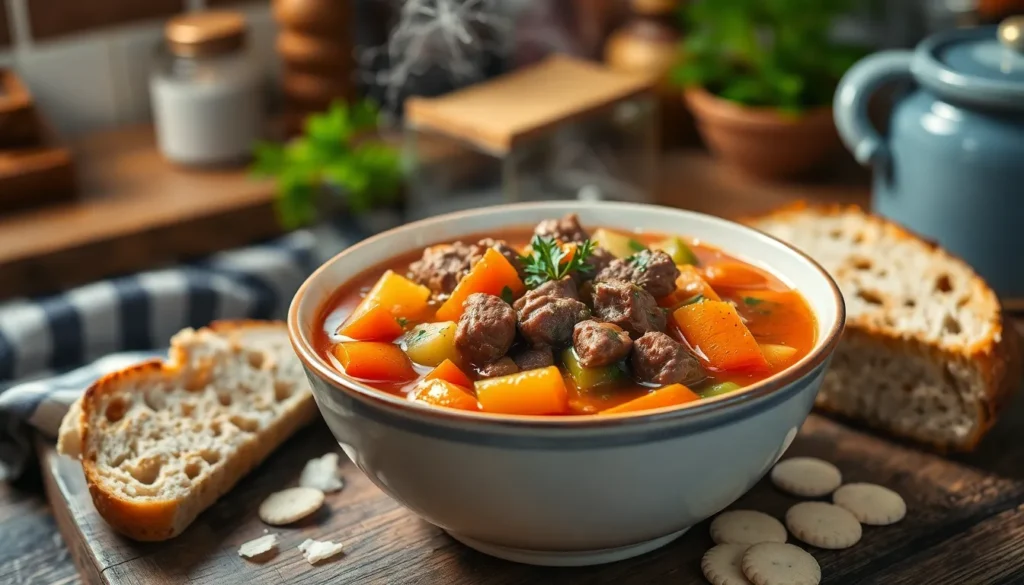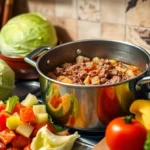Nothing beats a steaming bowl of homemade vegetable beef soup on a chilly day. This hearty comfort food combines tender chunks of beef with fresh vegetables in a rich, savory broth that’ll warm you from the inside out. We’ve perfected this classic recipe to deliver maximum flavor with minimal fuss.
Our vegetable beef soup recipe transforms simple ingredients into something extraordinary. The secret lies in browning the beef first to develop deep, caramelized flavors that infuse the entire pot. Fresh carrots, celery, potatoes, and green beans add texture and nutrition while creating a colorful, appetite-appealing dish.
This one-pot wonder makes meal prep effortless and cleanup a breeze. Whether you’re feeding a hungry family or meal prepping for the week ahead, this soup delivers comfort food satisfaction that’ll have everyone asking for seconds. Let’s jump into creating this soul-warming masterpiece that’s destined to become your go-to cold-weather recipe.
Ingredients
We’ve carefully selected each ingredient to create the perfect balance of hearty beef and vibrant vegetables in our vegetable beef soup. These components work together to build layers of flavor that make this soup truly exceptional.
For the Beef
- 2 pounds beef chuck roast, cut into 1-inch cubes
- 2 tablespoons olive oil
- 1 teaspoon salt
- 1/2 teaspoon black pepper
- 1 tablespoon all-purpose flour
For the Vegetables
- 3 medium carrots, peeled and sliced into 1/4-inch rounds
- 3 celery stalks, chopped into 1/2-inch pieces
- 1 large yellow onion, diced
- 3 medium potatoes, peeled and cubed
- 1 cup green beans, trimmed and cut into 1-inch pieces
- 1 cup corn kernels (fresh or frozen)
- 1 cup peas (fresh or frozen)
- 3 garlic cloves, minced
- 1 can (14.5 oz) diced tomatoes, undrained
For the Broth Base
- 8 cups beef broth
- 2 tablespoons tomato paste
- 2 bay leaves
- 1 teaspoon dried thyme
- 1 teaspoon dried oregano
- 1/2 teaspoon paprika
- 1/4 teaspoon cayenne pepper (optional)
- Salt and pepper to taste
- 2 tablespoons fresh parsley, chopped
Equipment Needed
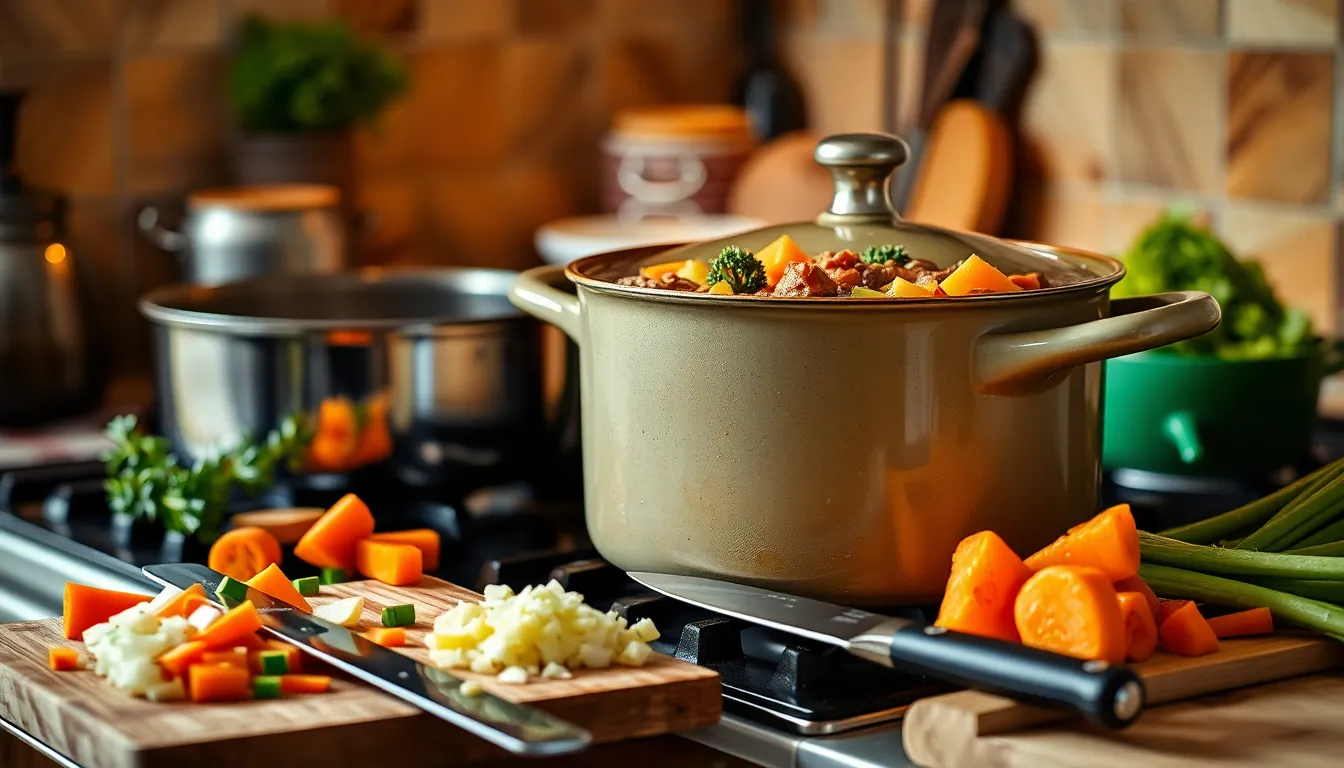
We’ve designed this vegetable beef soup recipe to work with basic kitchen equipment that most home cooks already have. The equipment list focuses on creating an efficient cooking process while ensuring your soup develops maximum flavor.
Our primary cooking vessel needs to be a large pot or Dutch oven with at least 6-quart capacity. This heavy-bottomed cookware provides even heat distribution and prevents scorching when browning the beef. The Dutch oven’s superior heat retention also helps maintain consistent simmering temperatures throughout the cooking process.
We recommend having a sturdy cutting board and sharp knife ready for ingredient preparation. These tools handle the chopping of onions, celery, carrots, and potatoes efficiently. A well-maintained knife makes the prep work safer and faster.
Measuring cups and spoons ensure accurate ingredient proportions for consistent results every time we make this soup. We use these for measuring the olive oil, garlic powder, and hot pepper sauce portions.
A wooden spoon or spatula becomes essential for stirring and scraping up the flavorful browned bits from the pot bottom. This tool won’t scratch your cookware surface while effectively incorporating all ingredients.
Ladle serves as our go-to tool for serving the finished soup into bowls. Its deep bowl design makes portioning clean and prevents spills.
Finally, we need a reliable stove or heat source that maintains steady medium-high heat for browning and consistent low heat for the extended simmering process. The cooking method requires temperature control for optimal beef tenderness and vegetable texture.
This minimal equipment list keeps the preparation straightforward while delivering restaurant-quality results in our home kitchen.
Prep Work
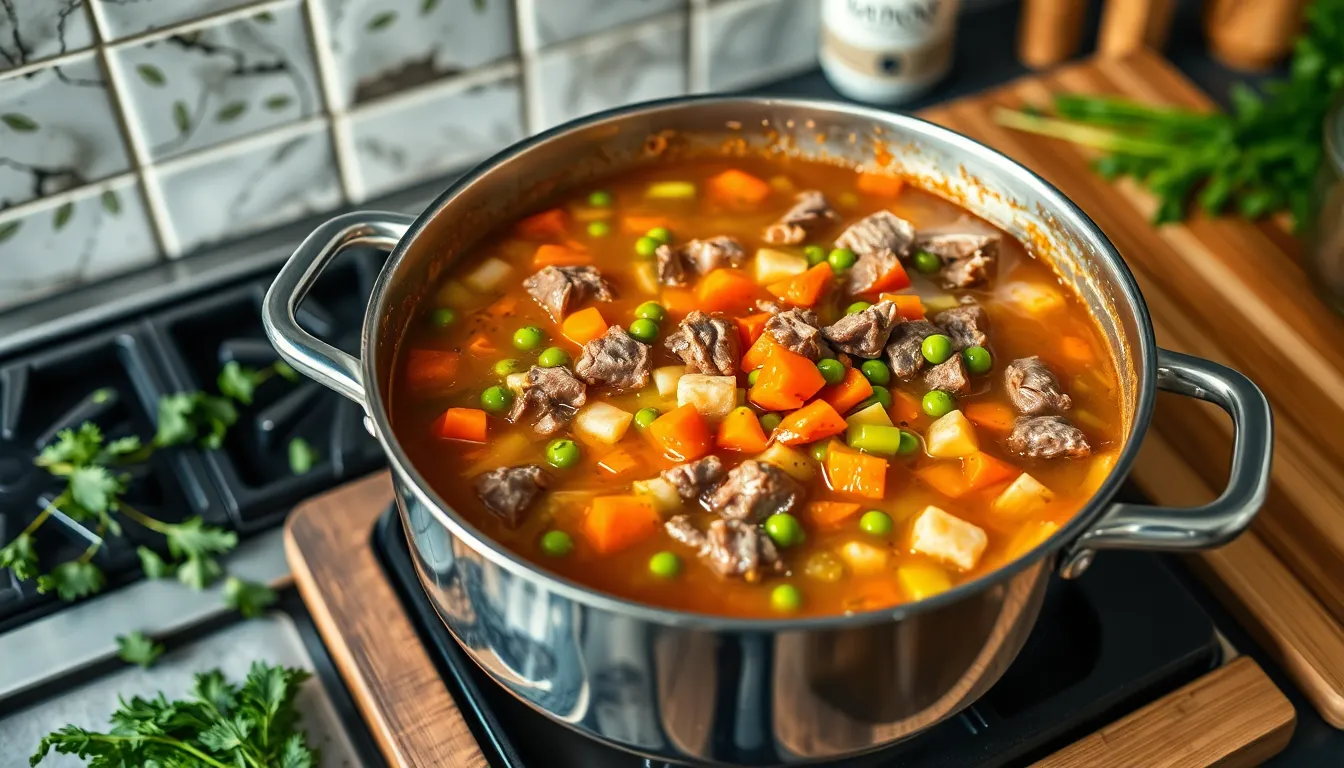
We organize our vegetable beef soup preparation into three essential stages that build maximum flavor. This systematic approach ensures perfectly tender beef and vibrant vegetables in every bowl.
Preparing the Beef
We start by selecting beef stew meat and cutting it into bite-sized chunks for even cooking. Paper towels help us dry each piece thoroughly before seasoning generously with salt and pepper.
Heat 1-2 tablespoons of olive oil in our large pot or Dutch oven over medium-high heat. We brown the beef in small batches for 4-6 minutes per batch, turning pieces to sear all sides until they release easily from the pan. This browning step develops the deep, rich flavor that makes our soup exceptional.
Once properly browned, we remove the beef and set it aside while preparing our vegetables. The flavorful bits left in the pot will enhance our broth later.
Chopping the Vegetables
We prepare our core vegetables first: onions, carrots, and celery form the foundation of our soup’s flavor profile. Dice the onions and celery into uniform pieces, then chop carrots into bite-sized chunks that match our beef pieces.
Additional vegetables like zucchini, potatoes, peas, corn, and green beans can join the mix based on preference and seasonal availability. We mince our garlic separately since it cooks much faster than the other vegetables.
Organizing all chopped vegetables on our cutting board keeps the cooking process smooth and efficient.
Preparing the Broth
We return to our pot with the browned beef drippings and add more oil if needed. The chopped onions, carrots, and celery go in first, sautéing for 3-5 minutes until they begin to soften and release their aromas.
Add the minced garlic and cook for just one minute more to prevent burning. We stir in tomato paste next, cooking it for about 2 minutes until it darkens slightly and develops a richer flavor.
Pour in the beef broth and canned diced tomatoes, then add our herbs: basil, oregano, thyme, salt, and pepper. We return the browned beef to the pot and add extra water if needed to cover all ingredients.
Bring the mixture to a boil, then reduce heat to low and cover. We simmer for 30 minutes to 2 hours depending on how tender we want our beef. Quick-cooking vegetables like peas and corn join the pot during the final 10-15 minutes to maintain their texture and bright color.
Instructions
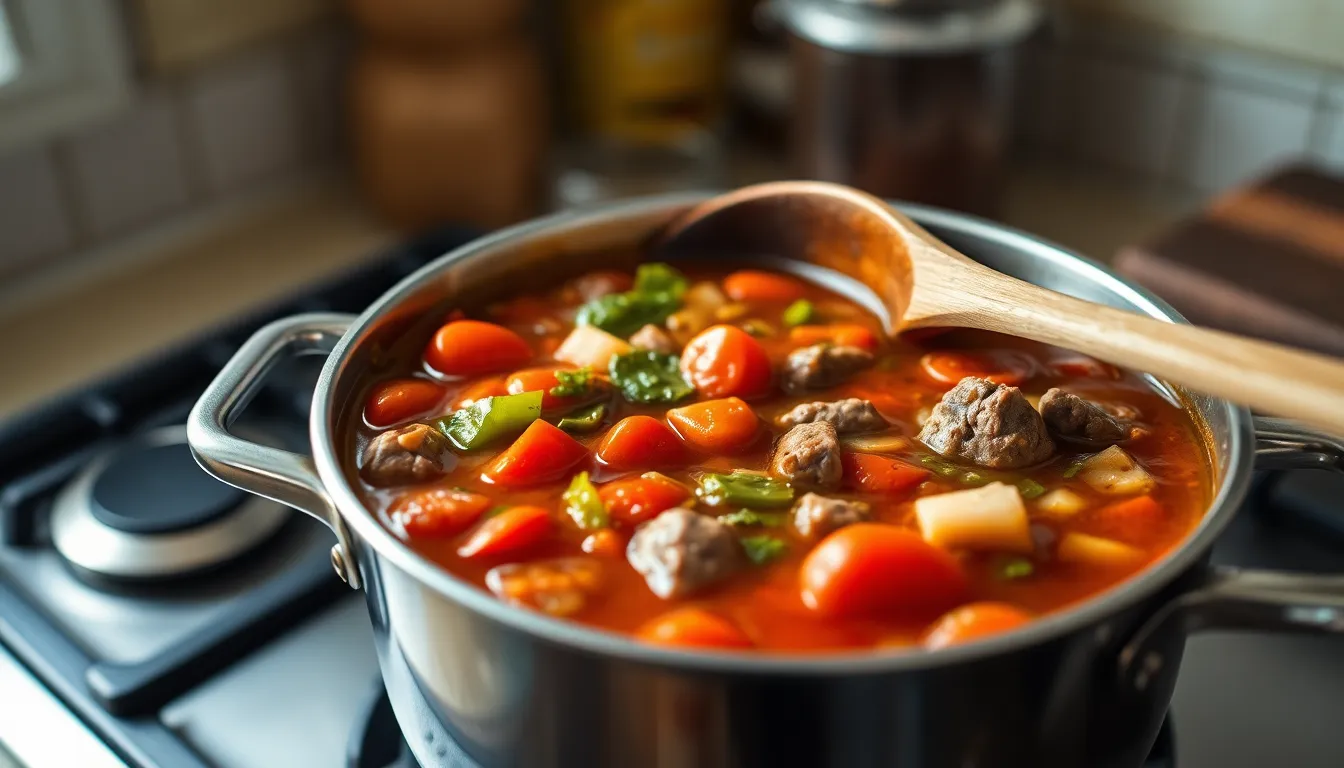
We begin our soup making process with these essential steps that build layers of rich flavor. Follow each stage carefully to achieve the perfect balance of tender beef and vibrant vegetables.
Browning the Beef
We start by patting our 1 to 1.5 pounds of beef stew meat completely dry with paper towels. Season the meat generously with salt and pepper on all sides. Heat 1 to 2 tablespoons of olive oil in our large pot or Dutch oven over medium-high heat until the oil shimmers.
Brown the beef in small batches to prevent steaming, cooking each batch for approximately 4 minutes while turning the pieces halfway through. We want all sides beautifully browned and caramelized. Remove each batch of browned beef to a plate and set aside while we continue with the remaining pieces.
Building the Base
Add more oil to the same pot if needed, then sauté our chopped yellow onion, carrots, and celery in the flavorful beef drippings. Cook these aromatics for 3 to 10 minutes until the onions become translucent and begin to develop golden edges.
Stir in the minced garlic and cook for one additional minute until fragrant. Pour in the beef broth and canned diced tomatoes with their juice, scraping up any browned bits from the bottom of the pot. Return our beautifully browned beef to the pot along with any accumulated juices.
Season the mixture with basil, oregano, thyme, and bay leaves, plus additional salt and black pepper to taste. Bring everything to a rolling boil, then reduce the heat to low and cover the pot.
Adding Vegetables
Include our root vegetables like potatoes and any additional carrots along with the celery and onion that form our flavor base. These heartier vegetables need the full cooking time to become tender and absorb the rich broth flavors.
Reserve quick-cooking vegetables such as frozen peas and corn for later addition. We add these delicate vegetables during the final 30 minutes of cooking to maintain their bright color and pleasant texture.
Simmering the Soup
Allow the soup to simmer gently with the lid slightly ajar to concentrate flavors and achieve the perfect consistency. The beef requires 1.5 to 2 hours of total cooking time to become fork tender and easily shreddable.
Add our quick-cooking vegetables like peas during the last 30 minutes of cooking time. Taste and adjust seasoning with additional salt, pepper, or herbs as needed before serving. Remove the bay leaves and serve hot with crackers or crusty bread for the ultimate comfort meal experience.
Cooking Tips
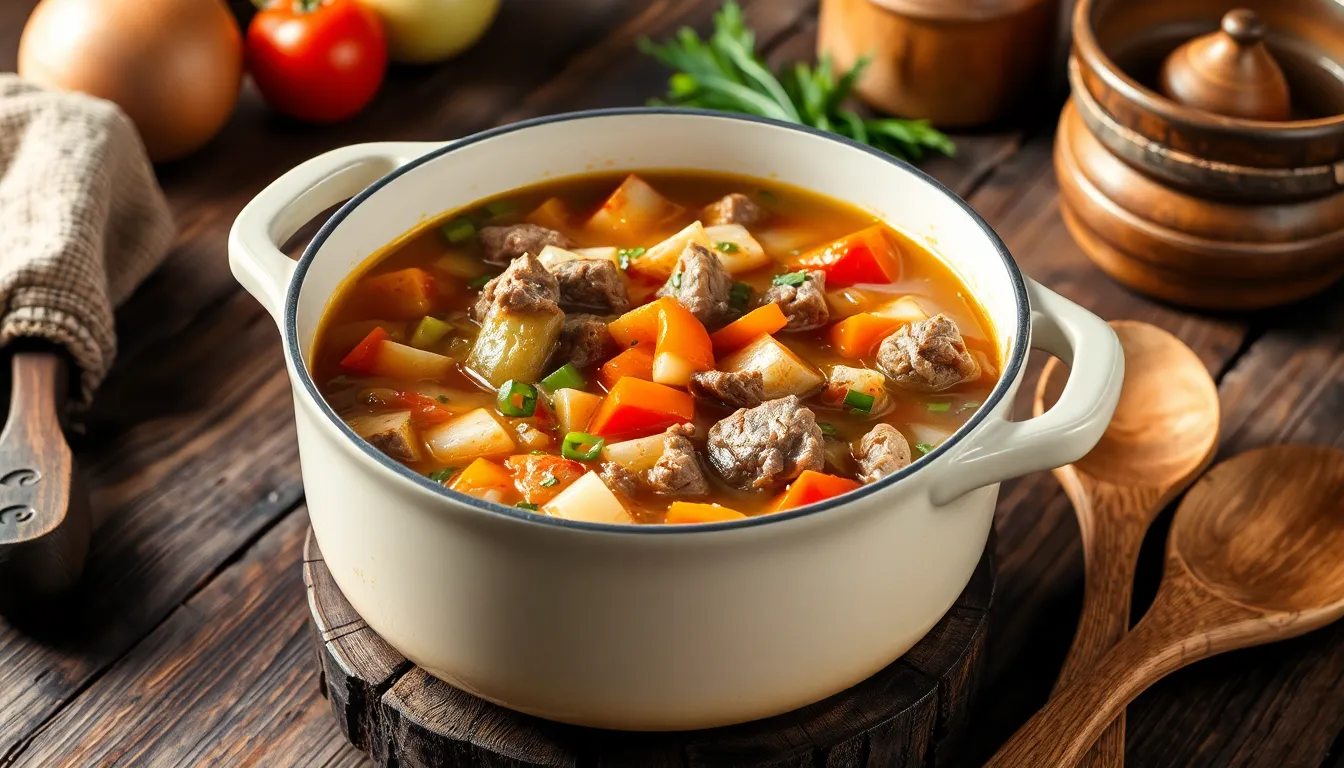
We’ve gathered proven techniques to help you create the most flavorful and tender vegetable beef soup. These professional tips will ensure your soup turns out perfectly every time.
Achieving Perfect Tenderness
We recommend using beef chuck or stew meat specifically because these cuts become incredibly tender through slow simmering. Brown the beef first to develop rich flavor and seal in the natural juices. This crucial step creates a caramelized exterior that adds depth to our soup base.
Simmer the soup uncovered initially to concentrate flavors before covering during the final tenderizing phase. We cook the beef slowly for 1 to 1.5 hours to ensure it becomes fork tender without drying out. The key lies in maintaining a gentle simmer rather than a rolling boil throughout the cooking process.
Adding vegetables in stages prevents overcooking the softer ingredients while allowing heartier vegetables to cook thoroughly. Root vegetables like potatoes and carrots should join the pot early while delicate items like peas require only the final few minutes of cooking time.
Seasoning Adjustments
We add salt gradually while tasting as we go since both broth and canned tomatoes already contain salt. Start with less than you think you need and build up the flavor slowly. Freshly ground black pepper adds brightness when stirred in just before serving rather than during the long cooking process.
Italian seasoning or a combination of thyme, rosemary, and bay leaves creates the perfect savory herb profile for our soup. Hot pepper sauce or flakes can be adjusted based on your desired spice level. We prefer adding these heat elements toward the end so we can control the intensity.
Fresh herbs like parsley bring color and freshness when added at the very end of cooking. This final touch brightens the entire dish and provides a beautiful garnish that makes our soup look as good as it tastes.
Make-Ahead Instructions
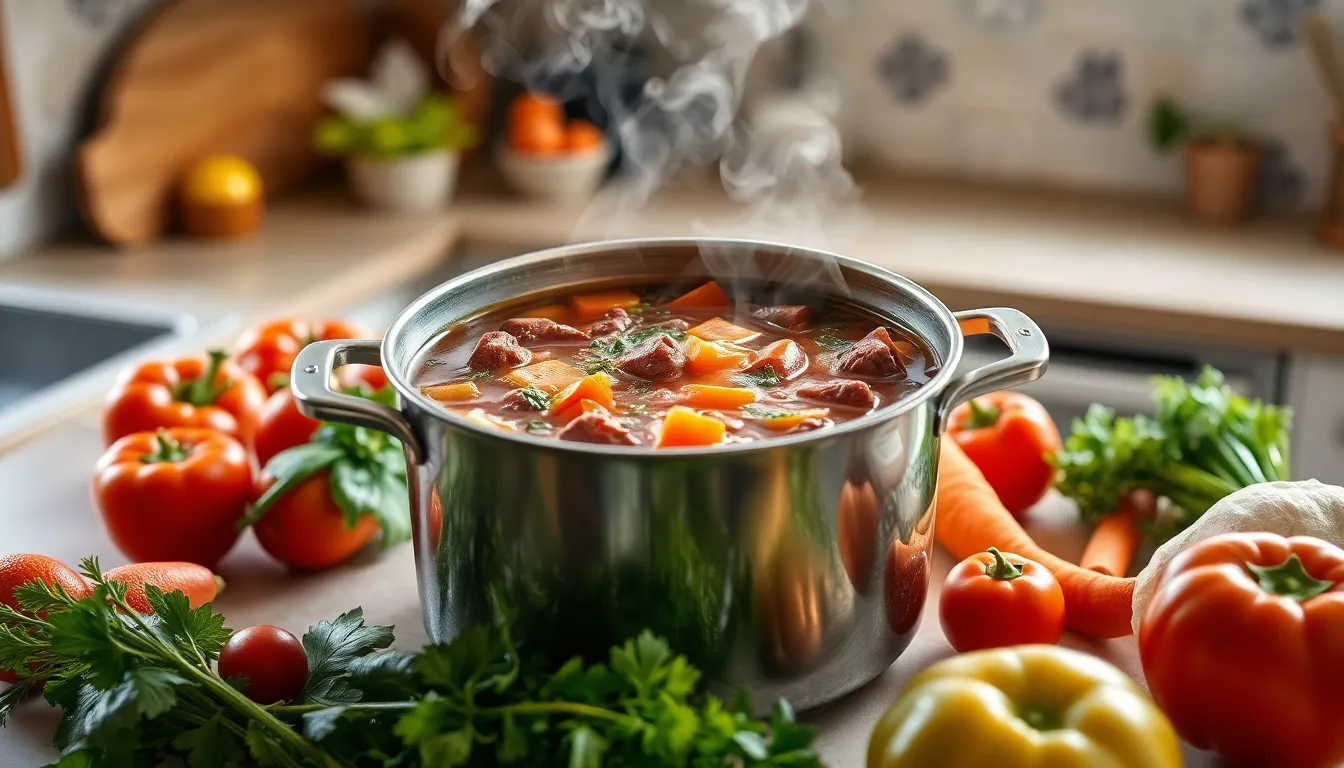
We love preparing this vegetable beef soup ahead of time because it makes weeknight dinners effortless and the flavors actually improve with time. Our soup stores beautifully in the refrigerator for up to 5 days, making it perfect for meal prep or batch cooking sessions.
Refrigerator Storage
Allow the soup to cool completely before transferring it to airtight containers. We divide large batches into family-sized portions for easy reheating throughout the week. The beef becomes even more tender as it rests, and the vegetables absorb more of the savory broth flavors.
Freezer Storage
For longer storage, we freeze our vegetable beef soup for up to 2 months without losing quality. Portion the cooled soup into freezer-safe containers, leaving about an inch of headspace for expansion. Label each container with the date and contents for easy identification.
Reheating Guidelines
Thaw frozen soup overnight in the refrigerator before reheating. We reheat refrigerated portions on the stovetop over medium heat, stirring occasionally until heated through. For frozen portions, we recommend thawing first to ensure even heating and prevent scorching.
Special Considerations for Pasta Additions
If you plan to add pasta or rice to your soup, we suggest keeping these starches separate until serving time. Cook pasta or rice fresh and add it to individual bowls before ladling the hot soup over top. This prevents the starches from becoming mushy during storage and maintains the perfect texture.
Flavor Enhancement Over Time
Slow cooker versions of this soup taste particularly exceptional the next day as the flavors continue to meld together. We often make our soup a day ahead of serving for the most developed, rich taste that truly showcases the harmony between the beef and vegetables.
Storage and Reheating
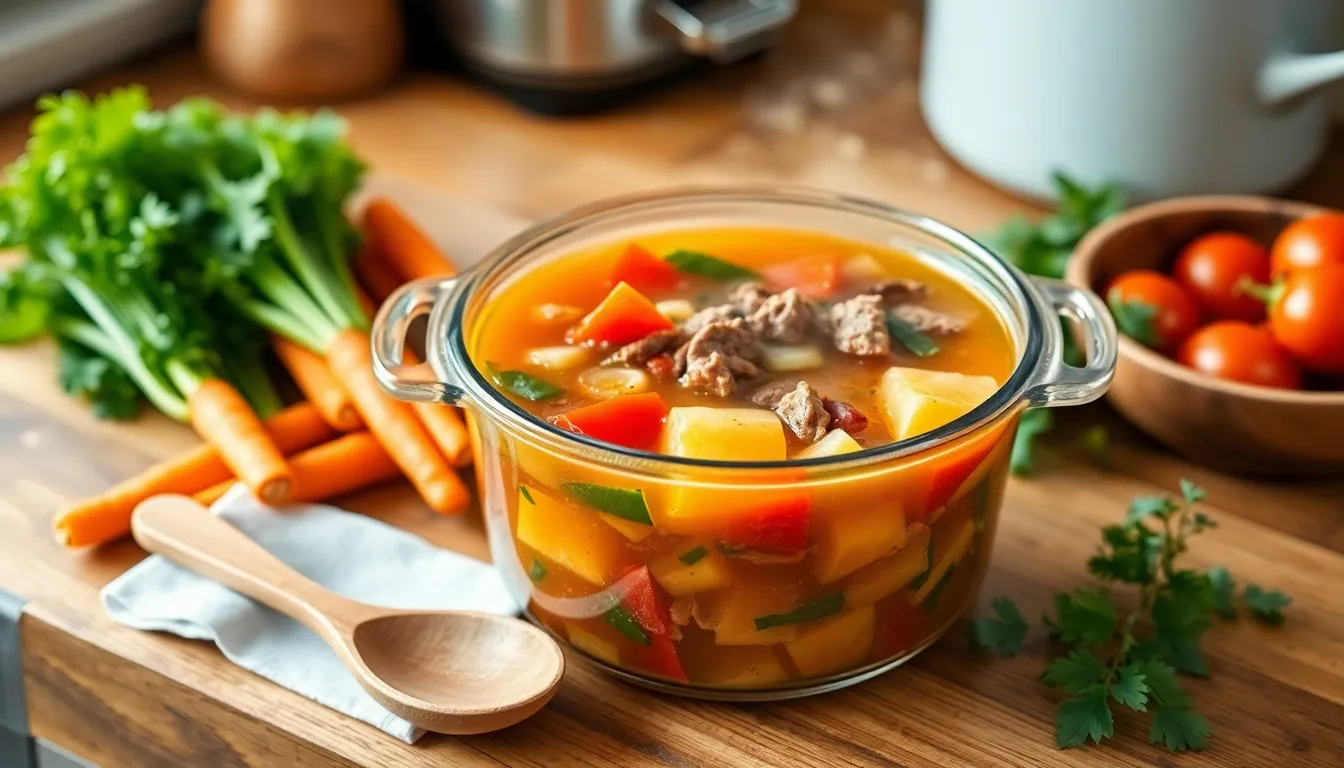
Proper storage extends the life of our vegetable beef soup while maintaining its delicious flavor and texture. We recommend allowing the soup to cool completely to room temperature before transferring it to storage containers. This prevents condensation from forming inside the containers and helps preserve the soup’s quality.
Refrigerator Storage
We store our cooled soup in airtight containers for optimal freshness. The soup keeps well in the refrigerator for up to 3-4 days when properly stored. Glass containers work exceptionally well for storing soup as they don’t absorb odors and heat evenly during reheating.
Freezer Storage
For longer storage periods we freeze portions of our vegetable beef soup in freezer-safe containers or heavy-duty freezer bags. The soup maintains its quality for up to 3 months in the freezer. We recommend labeling containers with the date to track freshness and using freezer bags for efficient space utilization.
| Storage Method | Duration | Container Type |
|---|---|---|
| Refrigerator | 3-4 days | Airtight containers |
| Freezer | 3 months | Freezer-safe containers or bags |
Reheating Guidelines
We reheat our refrigerated soup gently on the stovetop over medium heat. Stirring occasionally ensures even heating throughout the soup. The stovetop method gives us the best control over temperature and prevents the vegetables from becoming mushy.
Microwave reheating works well for single portions when we use a microwave-safe container. We cover the container loosely and heat in intervals while stirring between sessions to ensure uniform heating. This method prevents hot spots that can overcook certain ingredients.
Frozen soup portions require overnight thawing in the refrigerator before reheating. We add a splash of beef broth or water if the soup appears too thick after chilling since the liquid tends to reduce during storage. The soup’s consistency returns to normal once properly reheated and stirred.
Serving Suggestions
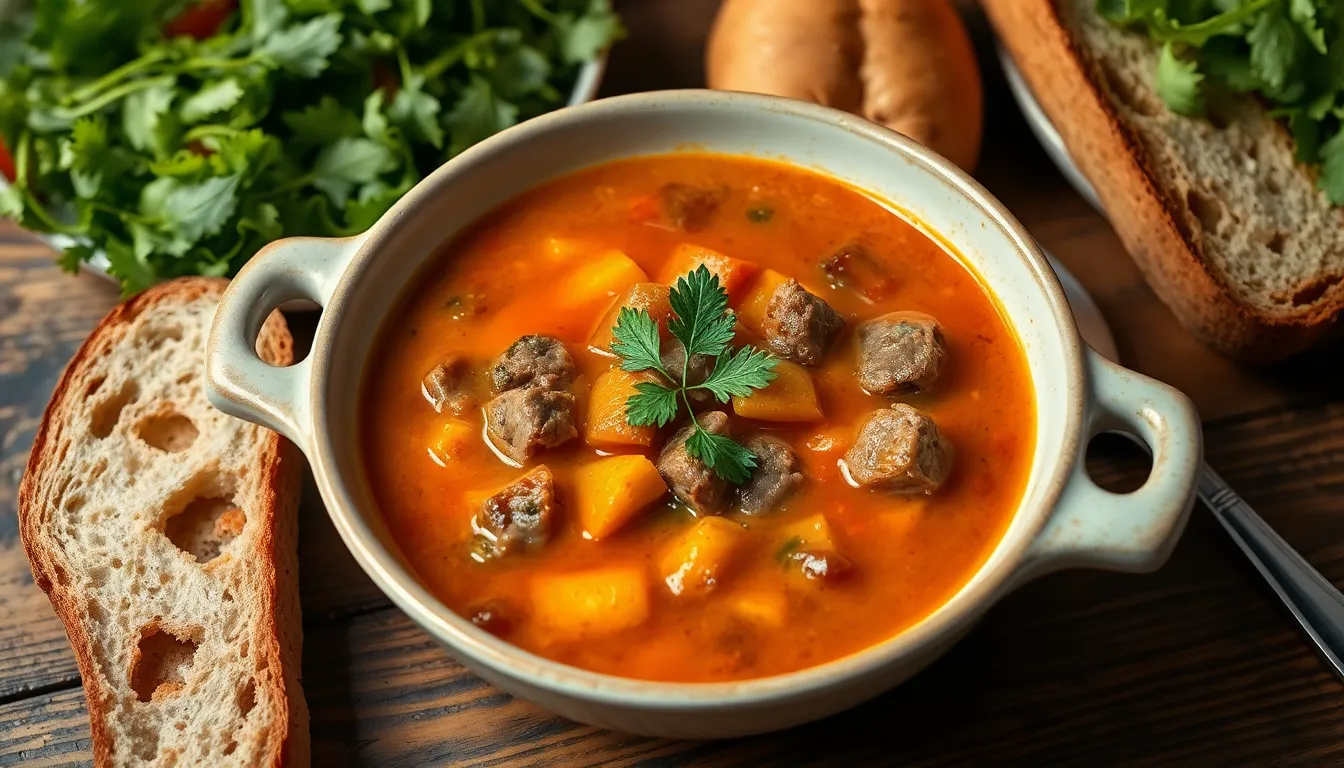
Our hearty vegetable beef soup becomes even more satisfying when paired with the right accompaniments. We recommend serving this comforting soup piping hot with a side of crusty bread or freshly baked dinner rolls to soak up every drop of the flavorful broth. Crumbled saltines offer a classic texture contrast that adds a delightful crunch to each spoonful.
Fresh herbs transform the presentation and elevate the flavors significantly. We love garnishing each bowl with chopped fresh parsley or thyme just before serving. These aromatic herbs brighten the rich broth and add a pop of color that makes the dish visually appealing.
A fresh green salad creates the perfect balance for this hearty soup. We suggest serving crisp mixed greens with a light vinaigrette alongside the soup to complete the meal. The fresh vegetables provide a refreshing contrast to the warm comfort of the soup.
Our vegetable beef soup shines as a cozy fall or winter meal when temperatures drop. We find that serving it in warmed bowls helps maintain the perfect temperature throughout the meal. The soup’s rich flavors and tender beef make it an ideal choice for family dinners or casual entertaining.
Leftover soup actually improves in flavor overnight as the ingredients continue to meld together. We recommend reheating individual portions gently on the stovetop or in the microwave for a quick and satisfying meal. The soup maintains its delicious taste and hearty texture even after being stored and reheated.
| Serving Detail | Recommendation |
|---|---|
| Yield | 4-6 servings |
| Ideal Season | Fall and winter |
| Reheating Quality | Excellent |
| Flavor Development | Improves overnight |
Recipe Variations
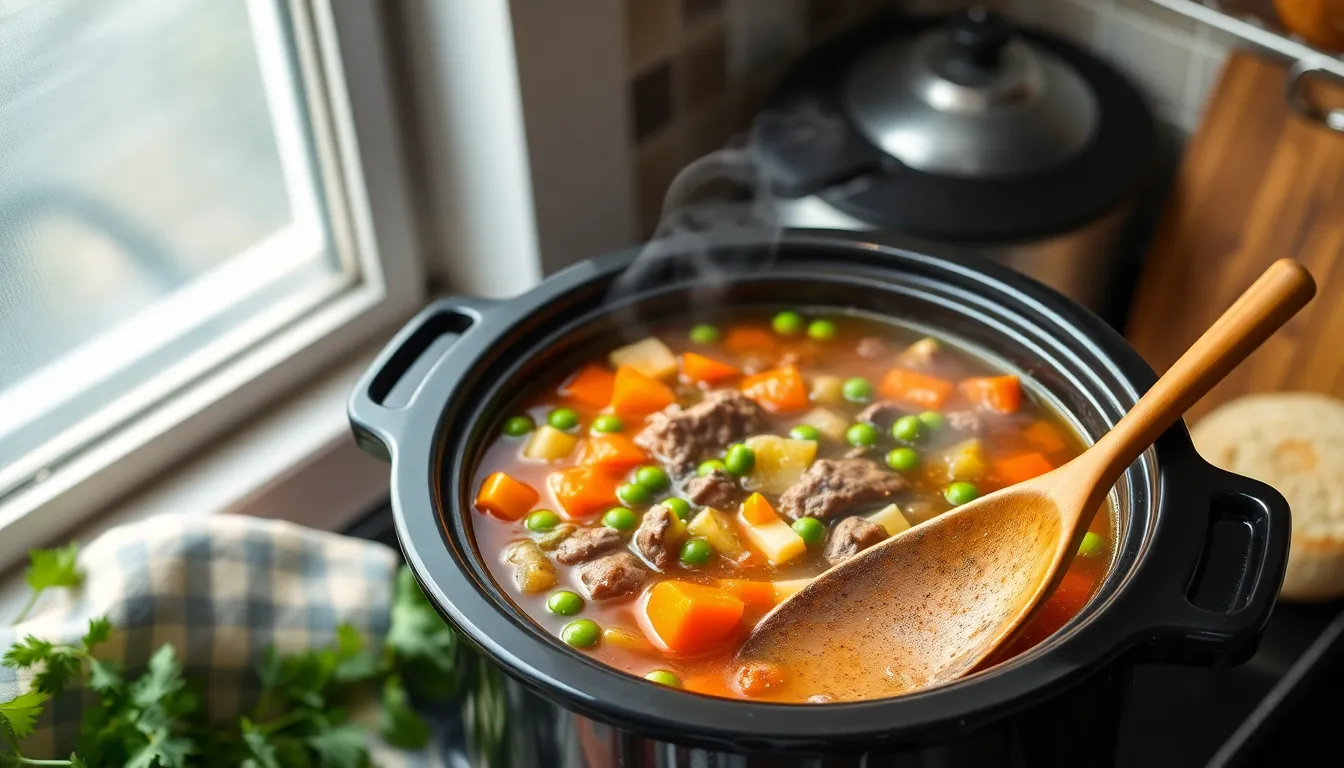
Our vegetable beef soup adapts beautifully to different cooking methods and personal preferences. These variations allow you to customize the recipe based on your available time and equipment.
Slow Cooker Method
We love using a slow cooker for this recipe because it creates incredibly tender beef with minimal effort. Brown 2 pounds of beef stew meat in olive oil before transferring to your slow cooker. Sauté the onions and celery separately, then add them to the slow cooker along with beef broth, diced tomatoes, and heartier vegetables like carrots and potatoes.
Set your slow cooker to low for 6-8 hours or high for 3-4 hours until the beef becomes fall-apart tender. Add delicate vegetables such as green peas during the last 30 minutes to prevent overcooking. The extended cooking time allows flavors to meld deeply while keeping your hands free for other tasks.
Instant Pot Method
Our Instant Pot version delivers the same rich flavors in a fraction of the time. Use the sauté function to brown your beef chunks and vegetables directly in the pot. Add beef broth, tomato paste, root vegetables, and seasonings before sealing the lid.
Cook on high pressure for 35-40 minutes, then perform a quick pressure release. Stir in quick-cooking vegetables like peas and simmer with the lid off for a few minutes if you need to thicken the broth. This method transforms tough stew meat into tender, flavorful pieces while maintaining the integrity of your vegetables.
Conclusion
We’ve shared everything you need to create this soul-warming vegetable beef soup that’ll become your go-to comfort food. From selecting the right cut of beef to mastering the perfect simmer this recipe delivers restaurant-quality results in your own kitchen.
The beauty of this soup lies in its flexibility – whether you prefer the traditional stovetop method slow cooker convenience or Instant Pot speed you’ll achieve the same rich satisfying flavors. Don’t forget that proper storage techniques ensure you can enjoy this hearty meal throughout the week.
Fire up your stove gather your ingredients and treat your family to a bowl of pure comfort. We’re confident this vegetable beef soup will earn its place among your most treasured cold-weather recipes.
Frequently Asked Questions
What cut of beef works best for vegetable beef soup?
Beef chuck roast or stew meat works best for vegetable beef soup. These cuts contain more connective tissue that breaks down during the long simmering process, resulting in tender, flavorful meat. The marbling in these cuts also adds richness to the broth as it cooks.
How long should I cook vegetable beef soup?
Vegetable beef soup should simmer for 1.5 to 2 hours total. This allows the beef to become fork-tender and the flavors to develop fully. Add heartier vegetables early in the cooking process, and quick-cooking vegetables during the final 30 minutes to maintain their texture and color.
Can I make vegetable beef soup ahead of time?
Yes, vegetable beef soup can be made ahead of time and actually improves in flavor overnight. Store it in the refrigerator for 3-4 days or freeze for up to 3 months. The flavors meld together beautifully, making it perfect for meal prep and busy weeknight dinners.
What vegetables should I add to beef soup?
Essential vegetables include onions, carrots, and celery as the base. Add potatoes, green beans, corn, and peas for variety. Add root vegetables early in cooking, and quick-cooking vegetables like peas and corn during the final 30 minutes to preserve their color and texture.
How do I store leftover vegetable beef soup?
Cool the soup completely before transferring to airtight containers. Store in the refrigerator for 3-4 days or freeze for up to 3 months. Label containers with dates for easy tracking. Reheat gently on the stovetop and add liquid if the soup thickens during storage.
Can I use a slow cooker or Instant Pot for this recipe?
Yes, both slow cooker and Instant Pot methods work well. Brown the beef first for maximum flavor, then add vegetables and broth. Slow cooker: cook on low 6-8 hours. Instant Pot: pressure cook for 35 minutes with natural release. Both methods produce tender, flavorful results.
Why is browning the beef important?
Browning the beef creates a caramelized exterior that adds rich, deep flavor to the soup. This process, called the Maillard reaction, develops complex flavors that enhance the overall taste. Always dry and season the beef before browning in batches for best results.
What should I serve with vegetable beef soup?
Serve with crusty bread or dinner rolls for dipping. Crumbled saltine crackers add texture, while fresh herbs like parsley or thyme provide color and flavor. A light green salad with vinaigrette makes a refreshing complement to this hearty soup.

